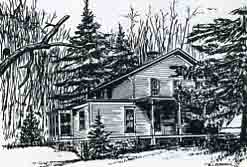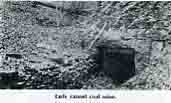
Ira Mansfield's Cannelton Home
Return to Milestones Vol. 3, No. 2
Here are the facts on Beaver County's 19th Century mineral curiosity, cannel coal. Don Inman of Patterson Township lent us his copy of Historical Collections of the Little Beaver River, from which the following article was taken. The original book is an album of botanical, geological, and historical information compiled by a man in love with the Little Beaver, Ira Mansfield.

There are probably but few persons in the United States and Canada who have not enjoyed the novelty and the genial warmth of the Little Beaver Cannel Coals. Not only on a cold winter's night do we realize a more grateful sense of the glowing qualities, but especially in summer camps, the nights are turned into day by its illuminating breath, burning with a bright flame like many candles and because of the chattering noise which it makes it is often called "parrot coal."
Cannel coal is plain and unpretending in its physical aspect, yet it is closely related to the higher order of mineral aristocracy-the diamond, as both are members of the carboniferous family.
As between the two, Cannel commends itself more warmly to our favor. Its origin, history and mission certainly deserve to be known. The origin of Cannel takes us back many millions of years; having developed many curious views as to how God "created the heavens and the earth and all that in them is."
The No. 4, or Darlington Cannel coal vein carries a general level through Ohio and. Pennsylvania being about sixty feet above level of the Little Beaver creeks. Many exposures, in both states miles apart, but only at Cannelton does the vein thicken to show both quantity and the high quality to command the eastern city markets in competition with foreign coals brought in as ballast and sold in our seaports. As to origin, some still hold to creation, others reason out formation from evaporation of ground oils, but science clearly teaches that twenty feet of Cannel is formed from vegetable matter, grown in situ, largely under water. Thin slices ofthe Cannel coal placed under the microscope, show it is more voody, or less decomposed than bituminous; disclosing the annular rings and scars of extinct tree ferns beautifully distinct, with even the medulary rays.
What is still more remarkable as to vegetable origin, in some examinations the spiral vessels could plainly be seen.
In burning the Cannel gives off steady flames of light, that gave to it, its early name of "Candle Coal." This name and the large outcropping of vein was revealed to the early settlers by the Indians. No special value was placed on exposure on the Mansfield and Morse tracts of land, presuming the vein was general under all lands. The mother shales underlying the Cannel coals have beautifully preserved many species of Nautilus sea shells, fossil tree ferns, showing flowers and fruits; several species of fishes; also bird-lizards with large wings and Eurypterus like cut that accompanies this subject. So highly developed are all forms of life in connection with Cannel, that we have the query: Must we discard the developments and evolution of life as shown in the later or upper coal veins?
The first mention of Candle coal is in 1752 when George Washington came from Virginia to Logstown on the Ohio. Bancroft's History says runners were sent out for the Indian chief Tannacharisson. He was found at Candle coal camp on the Little Beaver hunting wild turkeys. The first settlers George Foulks, Samuel McCaskey and John Hughes in 1795, in their old letters, speak of "candle coal for lights in place of candles." The mines always enjoyed a large trade to wagons and contracts were made to wagon the coal twenty miles to Rochester for delivery by Ohio river boats to Cincinnati and New Orleans. With the building of the Cannel Coal Railroad in 1852 the trade was extended to Gas Companies in all the New England States and Canada. The owners having a monopoly, kept the price at $2.50 per ton, f. o. b. on cars at the mine. By purchases in 1848 and 1852 Edwin Morse secured and operated the mines until his death in 1853 when Dr. E. Mygatt and C. F. Kirtland as executors of the estate continued the business, making the first shipments on the completed railway.
In 1856 the mine was leased with royalty at twentyfive cents per ton to Henreci and Lenz of the Harmony Society. They cleared $162,000 from sale of Cannel, but unwisely bought other lands and extended the railway, closing by selling all their interests, showing a loss of $360,000. In 1865 1. F. Mansfield leased the orchard lands with Cannel mine and successfully operated them until all the main basin of Cannel was worked out.
There still remains several thousand tons of choice Cannel that could be mined, but Natural Gas and Electric Lights has lowered the price of Cannel, leaving little demand or profit to the operator.
The analysis of Cannel coals show thirty per cent. of fixed carbon and sixty per cent. of volatile matter, being just the reverse of the best Bituminous coal. A New York company used several car loads of Cannel yearly in making finger rings, breastpins and buttons. Another firm Waterbury and Co. with large revolving retorts over fires, transformed Cannel into oil, and realized large profits from the by-products. Lately science takes Cannel coals and transforms entire products into colors, marking the great romance of modern science. Ages ago the gaudy flowers and plants that grew on this hot, moist planet decayed and being covered with rock were converted by pressure into Cannel coal. It is only for two centuries that man has know how to extract from coal the heat which was stored up in it during the carboniferous age. The latent colors needed only the magic touch of the synthetic chemist to be released. Now not only from the selected benches of Cannel, but the refuse slack, also the bench of Cannel slate-all utilized, more than four hundred coal tar colors have been rescued which are used in the manufacture of so-called "lakes," but generally for all grades of paints. Slowly these coal colors are being perfected to withstand chemical and atmospheric action. With some grades of coal colors no oils are required, only the use of water, giving bright and beautiful results.
As to the light which the Cannel from its products furnishes concerning its origin it may be noted that more than 500 species of plants have been found in it. They are algae 6 species; ferns 250 species; lycopods and club mosses 93 species; equisetas 13 species; sigilaria 60 species; noggerathia 12 species; asterophyllites 44 species and cycads 3 species; nearly all analogous to those now living in the tropics and are such as would require a moist climate.

The Cannel Coal underlying the Mansfield
and Morse tract and on adjoining lands were largely proved in
the general markets, when a company was formed under a special
Act of the Legislature of Pennsylvania, bearing
date of March 3rd, 1852, to build a railroad from the James Nicholson
farm (that was willed to his three slaves, Pompey, Tamar and Betsey)
to a place on the Ohio and Pennsylvania railway now known as New
Galilee, thence by Darlington and the North Fork of Little Beaver
to the Cannel mines-the charter allowing
extension to the Ohio state line. This Act of Legislature provides
penalties and rules, allows lateral branches, also dividends twice
a year; prohibits their men, cars or engines to do any work on
the Lord's Day and lands are not to be purchased exceeding two
hundred dollars per acre. The first directors were John White,
John McCowan, Edwin Morse, Atkinson Martin and Mathew Elder.
They organized in 1852 under the name of the Darlington Cannel Coal Railway Company, with a capital of one hundred and fifty thousand dollars to be raised by the issue of stock.
The capital stock of said company was divided into six thousand shares of twenty-five dollars each. of this Edwin Morse subscribed for and received two certificates calling for forty shares of stock. The railway was completed to Cannel Mines in 1855, the track being laid with 6x8 wooden stringers, using a strap iron rail 1-2x3 inches spiked down to wooden stringers, and for some time the ten ton cars were hauled from the mines to New Galilee by horses. A few months later they purchased the locomotive Economy, which did excellent service for thirty years. When the engine was dismantled Ira E. Mansfield secured the bell with frame, and the bell still rings up the Evergreen orchards daily at 12 and 5 o'clock.
The company to secure business, purchased and held in tee simple five hundred and fourteen acres of land, near the west terminal of the railway. To complete all improvements they secured a loan of forty thousand dollars from the Bank of Pittsburg, and a further loan of four thousand dollars from Benjamin Rush Bradford, giving mortgage bonds as security. In default on interest or any payments the bonds were placed on sale and purchased by the Harmony society. Henrici and Lentz as trustees, leased and operated the Cannel mines extensively, built car shops and extended the railway one mile west, opening up the Bituminous mines on their own lands. After the death of Edwin Morse, a director in the railway company, Cannel mine was operated by H. K. Morse, Dr. E. Mygatt and C. F. Kirtland as administrators until leased by Henrici and Lentz. The lease expiring in 1865, Ira F. Mansfield who had returned from three years' service in the Southern Rebellion, leased the mines from his aunt Eliza K. Glidden and furnished in the main all the business the railway did. In 1868 H. K. Morse, Lois Mansfield and 1. F. Mansfield purchased the life interest of Eliza K. Glidden, planted extensive orchards and leased the Bituminous coals to Freeman Butts and the Sterling Mining Company. The many railway investments of Henrici and Lentz, causing an outlay of four hundred thousand dollars proved a financial failure and in 1880 they sold the railway for forty thousand dollars to the P. L. & W. Company. This new company extended the railway twenty miles farther west to Lisbon, Ohio. They have enjoyed a fairly good business and the railway has returned the bond holders several thousand dollars each and every year over running expenses and all betterments.